Where is the market headed?
It was a decent day, with the Nifty holding steady, though other segments of the market showed limited participation.
Market Overview
Nifty closed 1.21% higher at 25,549, marking a strong session for the benchmark index.
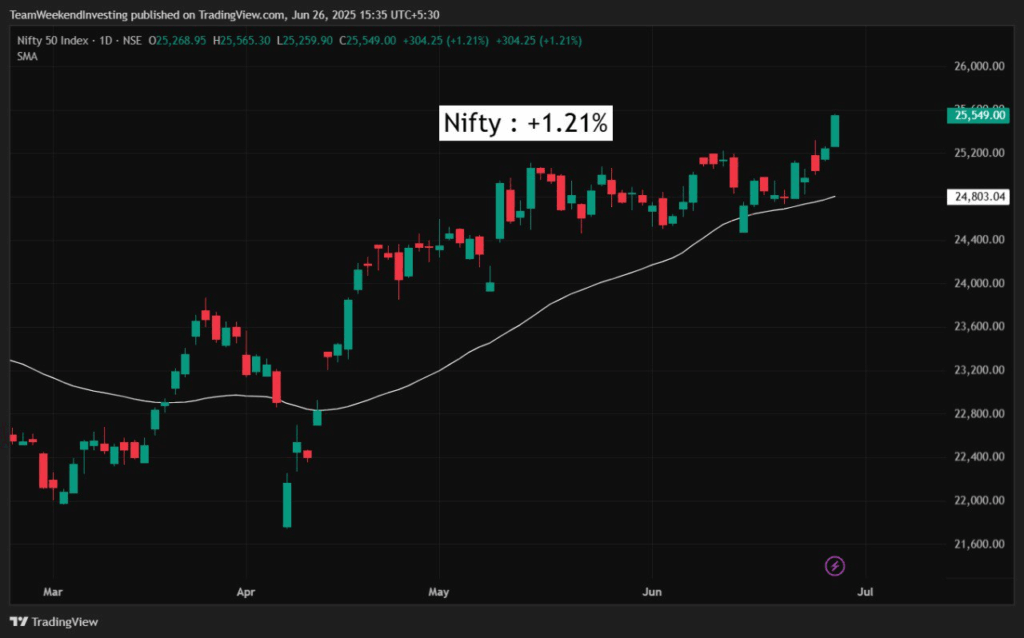
Nifty Next 50
Nifty Junior up by 0.92%.
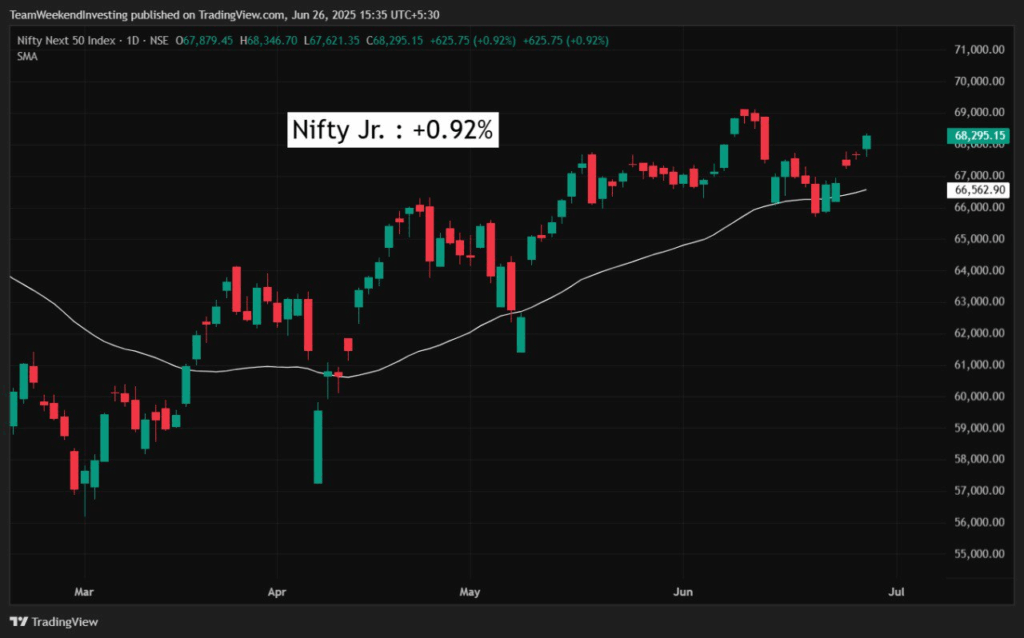
Nifty Mid and Small Cap
Mid caps are also hovering near recent highs, signalling underlying strength. However, small caps lagged, inching up just 0.26% despite Nifty’s strong rally.

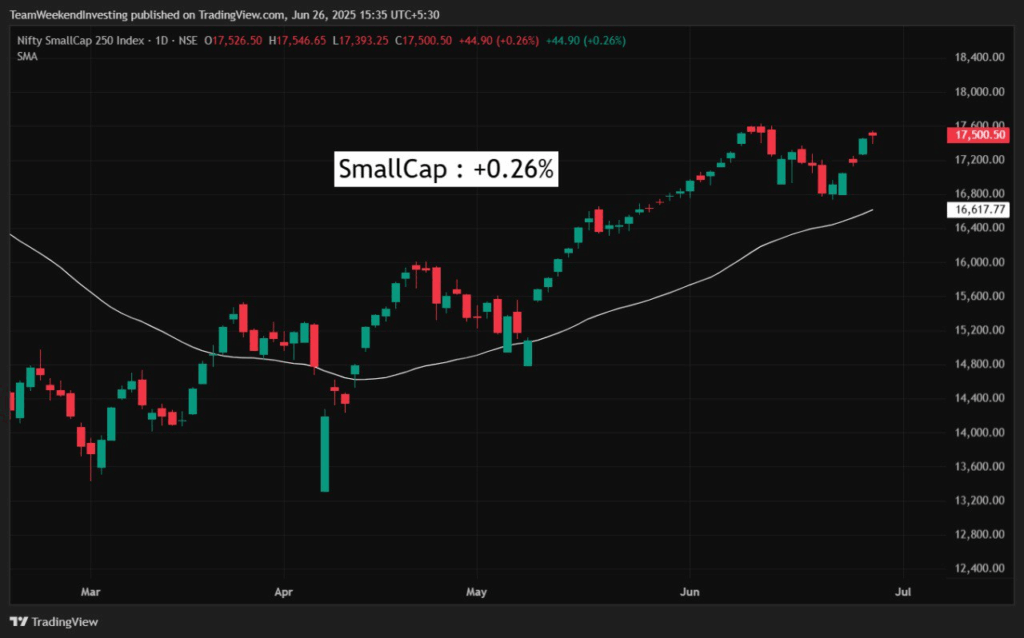
Bank Nifty
Nifty Bank surged to a fresh all-time high, closing at 57,206, up 1.03% for the day. Historically, strong moves in Nifty Bank often signal broader market strength, making this a significant development.
After a sharp rally in April, Nifty Bank had been consolidating for the past two months. This breakout suggests the start of a new upward leg, potentially mirroring the previous sharp rallies. Whether this momentum sustains will be key to watch in the sessions ahead.
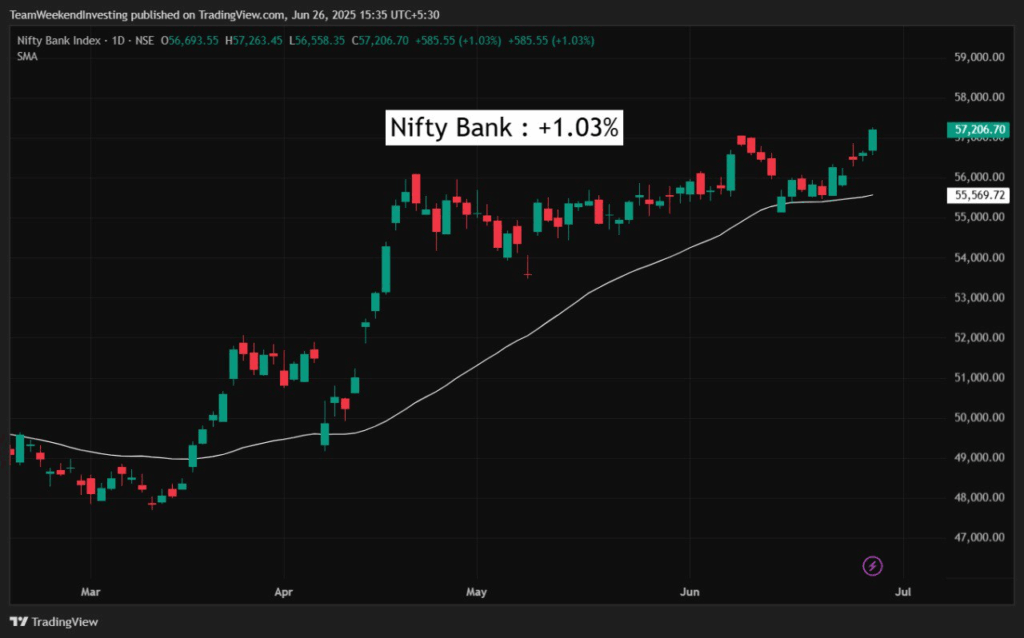
GOLD
Gold remained absolutely flat, closing at ₹9,754 per gram today.

Advance Decline Ratio
Advance-decline trends showed resilience through the day. After dipping around midday, advances recovered, mirroring the movement in declines.
The session began with a ratio close to 300 advances vs. 200 declines, and ended at nearly the same level, 297 advances to 200 declines—indicating that most stocks held on to their gains and market breadth remained steady.
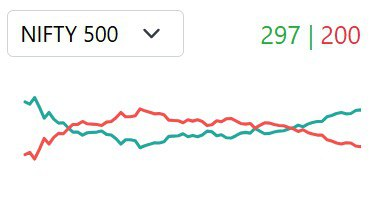
Heat Maps
The heat map reflects strong market sentiment, with substantial green across sectors. HDFC Bank, Reliance, Axis Bank, SBI Life, Shriram Finance, Jio Financial, Bajaj Finance, and Bharti Airtel all gained around 2%, indicating broad participation. Tata Motors rose 1.2%, while Tata Steel led with a 2.6% gain.
In the Nifty Next 50 segment, notable performers included Jindal Steel, Shree Cement, Vedanta, and several oil and power companies, contributing to a broadly positive day for the markets.
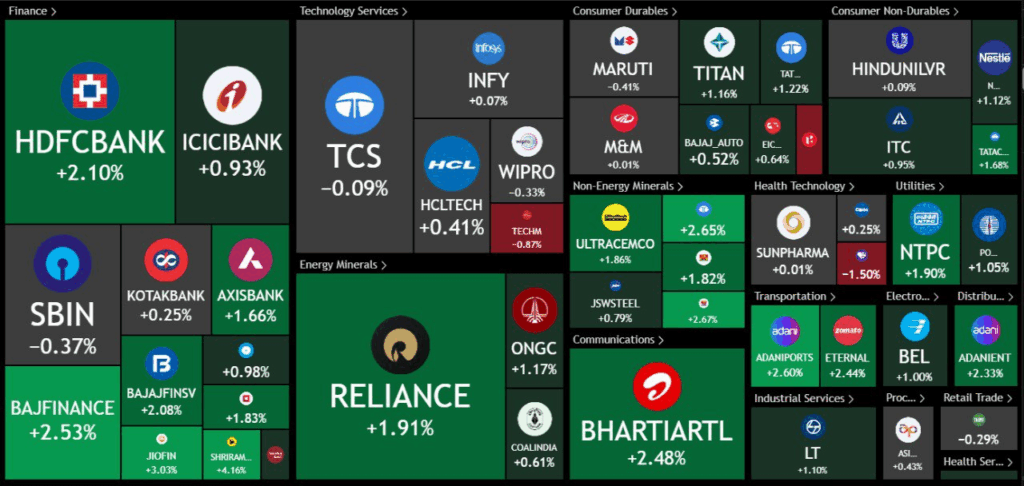
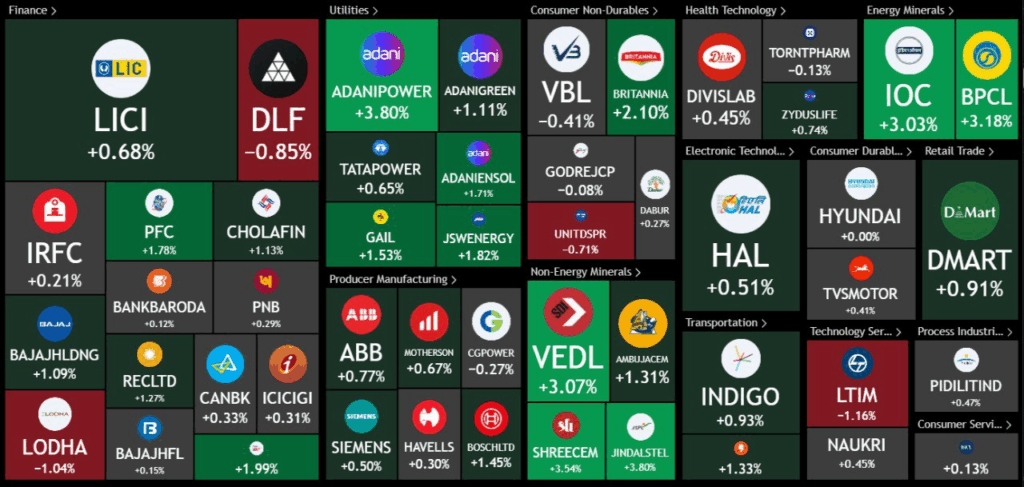
Sectoral Overview
The market ended on a strong note, with broad-based participation across sectors. Nifty Metals emerged as the top performer, rising 2.3% in a single session. It was closely followed by Oil & Gas, which gained 1.8%, and Commodities, which advanced 1.7%. The Infrastructure sector also posted solid gains of 1.6%, continuing its recent momentum.
Other notable contributors included Financial Services and Public Sector Enterprise stocks, both of which rose 1.4%. The Services sector, Private Banking, and Energy stocks registered a steady 1% gain each. Nifty Bank followed suit, also moving up 1%, reflecting strength in the broader financial space.
However, a few sectors lagged behind. Media stocks declined 1.09%, giving up recent gains. Real Estate also fell 1%, remaining flat after a strong showing the previous day. Pharma closed flat with no meaningful movement, while FMCG remained under pressure.
Over a longer horizon, FMCG has shown limited upside—up only 4% in the past three months and down 2.38% over the last year. Similarly, Real Estate has underperformed with a yearly decline of 8%. These trends suggest that while cyclicals and high-beta sectors are driving the current rally, defensives continue to lag.
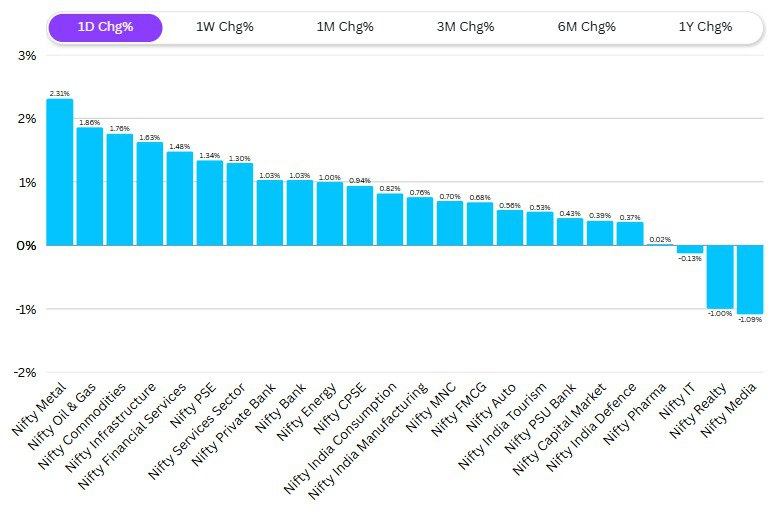
Sector of the Day
Nifty Metal Index
The Nifty Metal index has seen a strong resurgence, gaining 5.5% over the past week, making it one of the top-performing sectors recently. Over a one-month period, it is up 2%, and over three months, it has returned about 5%. The six-month gain stands at 8%, but the one-year change remains flat, highlighting its underdog status.
Despite this muted long-term performance, the recent chart structure looks promising, indicating a potential breakout. Stocks driving this recovery include Hindustan Copper, Steel Authority of India (SAIL), Jindal Steel, National Aluminium, and Vedanta—all of which have shown strong momentum.
This renewed strength suggests that Nifty Metals may be entering a more sustained upward phase, supported by improved price action and sectoral rotation.
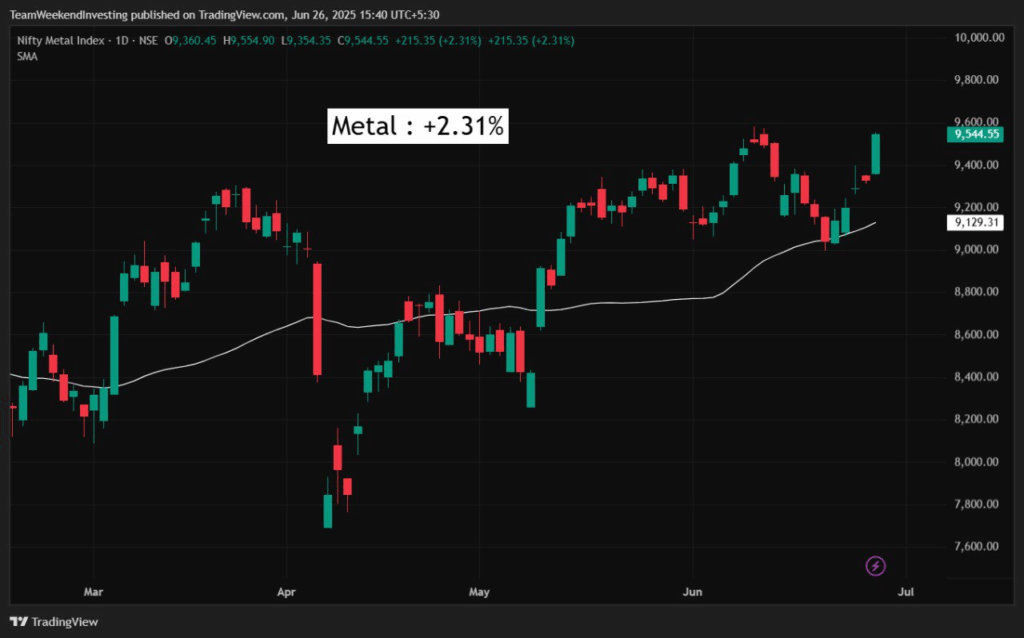
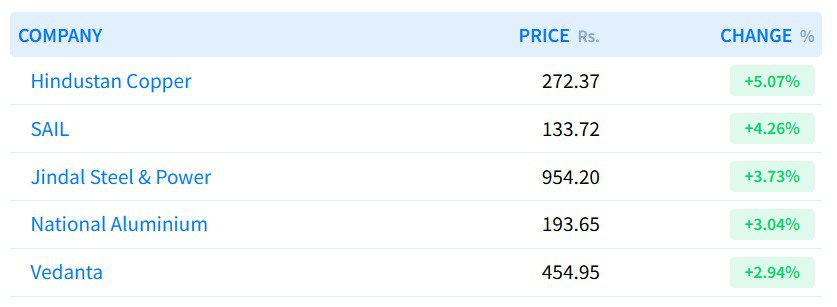
Story of the Day: Are You Sabotaging Your Portfolio with the Illusion of Control?
A powerful behavioural bias that often sneaks into investment decisions is the illusion of control—the belief that one can influence outcomes that are actually governed by chance or complex systems. This illusion, though subtle, can significantly impact decision-making and long-term returns.
The illusion of control is a cognitive bias where individuals believe they can influence results beyond their actual reach. In daily life, this can appear in small ways—pressing the accelerator harder when already at top speed, throwing dice with varying force in the hope of different outcomes, or repeatedly pressing the elevator button to make it arrive faster. These actions provide a false sense of control but do not change the result.
In the stock market, this bias frequently shows up as the urge to exit a stock after a small profit.

Investors often sell too early, driven by the fear of losing gains. For instance, a stock that gives a 2x return quickly may be sold off, even though it has the potential to continue rising (see the image above). In many cases, what could have been a 10- or 12-bagger turns into a missed opportunity because of premature exit. The illusion here is that locking in a small profit feels like good risk management. In reality, stocks with strong momentum often continue rising, and exiting early interrupts the compounding process.
Another example is stopping SIPs (Systematic Investment Plans) during market corrections.
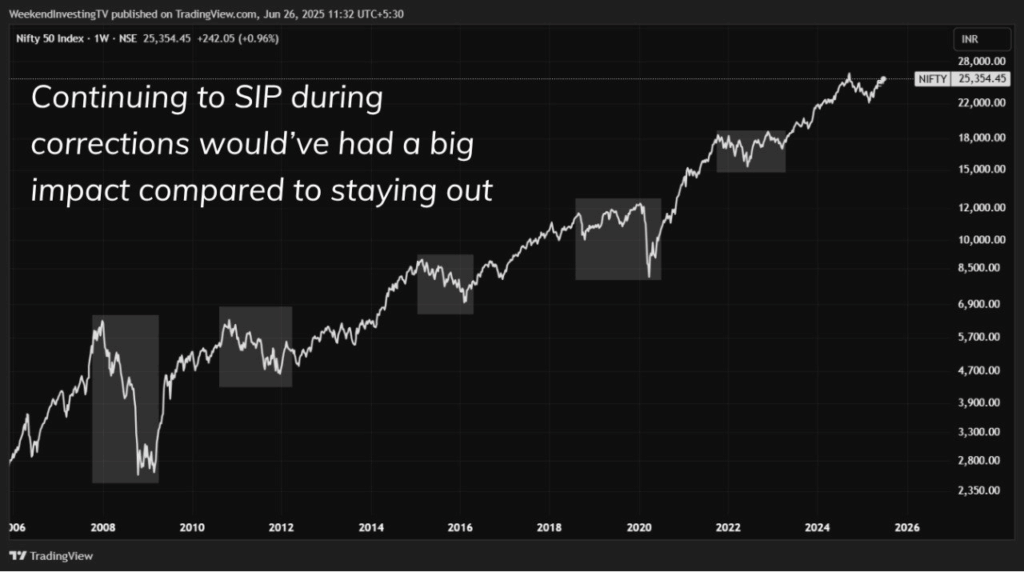
Many investors pause their investments during downturns, believing they are protecting their capital. However, this move defeats the very purpose of SIPs—averaging costs during volatile markets. The illusion is that one can time the bottom and resume later. In practice, re-entry is emotionally and mentally harder than expected. Acting for emotional comfort, instead of following a disciplined financial plan, leads to long-term setbacks.
The illusion also manifests when investors interfere with a rules-based strategy. For example, someone may remove a stock from a momentum portfolio just because of past bias—like skipping PSU stocks that underperformed years ago. Stocks like BHEL, Coal India, Indian Oil, and Power Finance Corporation have historically disappointed, but many of them later turned into massive wealth creators.
By letting emotions override data, investors end up missing such recoveries. Personal narratives replace objectivity, and despite the evidence in favour of certain moves, bias leads to inaction.
It’s important to recognise this illusion and avoid replacing data with emotion. If one is following a data-driven method, it’s crucial to stick with it and not inject personal preferences. Over the long run, trusting a consistent system outperforms emotion-led decisions.
More case studies on this topic will be shared in the next week blog. Until then, ask yourself: Are personal biases quietly influencing your portfolio decisions? and feel free to share your thoughts in the comments!







